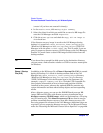
Disaster Recovery
Enhanced Automated Disaster Recovery of a Windows System
Chapter 10464
Any remaining partitions can be recovered using the standard Data
Protector recovery procedure.
The following sections explain the limitations, preparation, and recovery
that pertains to EADR of the Windows clients. See also “Advanced
Recovery Tasks” on page 490.
Before selecting this method of disaster recovery, consider the following
requirements and limitations:
Requirements
• The Data Protector Automatic Disaster Recovery component must be
installed on clients for which you want to enable recovery using this
method and on the system, where the DR CD ISO image will be
prepared. See HP OpenView Storage Data Protector Installation and
Licensing Guide.
• The hardware configuration of the target system must be the same as
of the original system. This includes SCSI BIOS settings (sector
remapping).
• Replacement disks have to be attached to the same host bus adapter
on the same bus.
• Boot partition has to be larger than 100 MB or disaster recovery will
fail.
• An additional 200 MB of free disk space is required on the boot
partition at backup time. If this disk space is not available, the
disaster recovery fails. If you had applied the Compress Drive on the
original partition, you must have 400 MB free.
• All drivers required for boot must be installed under <%SystemRoot%>
folder.
• Network must be available when you boot the system in Safe Mode
with Networking or in Directory Services Restore Mode (Domain
Controller only), but you must do the backup of the system after it
was booted with normal boot process.
• The system’s BIOS must support bootable CD extensions as defined
in the El-Torito standard and read/write access to hard disk drive
using LBA addressing via INT13h function XXh. The BIOS options
can either be checked in the user’s manuals of the system or by
inspecting the system setup before the boot.


















